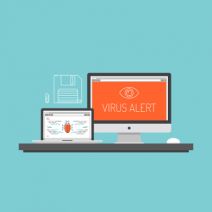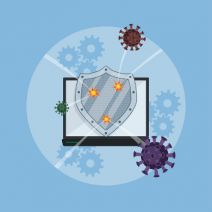Cybersecurity is intensely important, so a business owner would think implementing every security feature and defense would be a good idea. However, as research has shown, this can be counterproductive, as only 67% of surveyed security leaders know what led to cybersecurity incidents in their businesses over the past year.
Directive Blogs
Local small and medium-sized organizations are commonly targeted by cybercriminals simply because they let their guard down. A lot of local business owners seem to think “Hey, I’m just an accountant in Oneonta, or I’m just an insurance company in Sidney, or I’m just a realtor in Cooperstown, why would hackers want to target me?”
And the answer is right there. On top of that, the sheer number of avenues that cybercriminals have to cause damage to a business is staggering. Let’s take a look at some of the more recent threats we’ve been seeing over the past two months.
The world’s largest ticket retailer is in hot water after their parent company, Live Nation Entertainment filed an 8-K filing with the Security and Exchange commission admitting that they had been hacked to the tune of 1.3 terabytes of information. That amounts to 560 million customers’ personal information that has been stolen from the company’s servers. Today, we take a look at the hack and what it means for consumers.
Like many of the past few years, this year has witnessed a significant surge in high-profile ransomware attacks. If you haven't already strategized how to safeguard your business from these threats, now is the time to act. Fortunately, you can take several proactive measures to mitigate the impact of ransomware attacks, and it all starts with preparation.
Mobile malware isn’t common, but it’s growing increasingly more so. You may have heard of a malware called XLoader, which has been used to victimize people in over seven countries. This mobile threat has seen various iterations over the past several years, but you should be especially concerned these days.
2023 was definitely the year that AI became a household name. We’ve barely seen what artificial intelligence is capable of, and while industries are still coming up with more ways to use the technology, we’ve already seen countless examples of how people want to take advantage of AI for less savory purposes. 2024 is already shaping up to be the year that businesses need to protect themselves from AI-generated cybersecurity threats. Let’s take a look at everything you need to know as a business owner.
If you are old enough to remember when antivirus (like most computer software) came in a great big textbook-sized box at the store, then you probably remember a time when that was the only protection you really needed.
Today, there are countless free versions of antivirus out there. Let’s talk about how much protection these actually bring, and when and where they might be a good fit.
Businesses have embraced QR codes as a convenient means of sharing information with clients and customers. Unfortunately, this convenience is also enjoyed by cybercriminals who have decided to use QR codes for their own ends. QR code-based scams against businesses are on the rise, which is precisely why it is so important for organizations of all sizes to appreciate the risks that QR codes can present and know what they need to do to protect themselves.
We’re hoping that you are actually reading this post to prepare yourself if your business were to face a ransomware attack, but if you are suffering from one right now, we encourage you to reach out to us immediately, whether you are a client or not. Ransomware spreads quickly, and once it has infected a system, there really isn’t much you can do to stop it. However, there are steps you need to take to come back from this gracefully.
Chances are your business has a social media presence in at least some capacity, as it’s a good way to drive traffic to your business. However, hackers want to leverage this benefit against you. A new malware specifically targets Facebook business accounts to launch malicious advertisement campaigns using your own money against you.
The Internet is pretty great. You can watch videos of cats being weird, and then watch the London Philharmonic Orchestra perform Stravinsky’s Rite of Spring. Then you can go on Reddit and learn how to replace the drywall in your bathroom. Just another typical Sunday afternoon with the Internet, right?
Unfortunately, the Internet isn’t always perfect. It can be pretty dangerous, and we’d like to share some surprising terms that can lead to dangerous websites and malware if you search for them on Google.
It’s important to keep the software on your computer updated. If your operating system or web browser or some other important application is out of date, it could lead to things not working properly while also leaving you susceptible to threats. However, hackers are disguising malware to look like important web browser updates.
I hate to be the bearer of bad news, but when it comes to cybersecurity threats it’s kind of hard not to be. I used to look at it from two sides; one side is fascinated at the innovation and intensely brutal ways that high-end cyberattacks work, and the other side of me loses sleep at night worrying about these risks affecting our clients, prospects, and even my own business. This one particular classification of cyberattack, however, takes the cake for being especially frightening.
With technology being an integral part of our lives and society at large, cyberthreats continue to evolve and pose significant risks. One such threat that is on the rise is browser hijacking attacks. Let’s explore the dangers of these attacks, including the techniques employed by hackers, and how small and medium-sized businesses can protect themselves.
Ransomware is one of the more dangerous threats out there for businesses of all industries and sizes. To help emphasize just how dangerous it is, however, you have to look past the initial threat of having to pay a ransom and look at the other risks associated with it. We’re here to try to get the point across that ransomware is something your business should absolutely be taking seriously.
Ransomware is such a common occurrence these days that it has entered the public discourse, but we also want to note that it’s such an important topic to discuss with your team that you can never talk about it enough. We want to address some of the most common questions we get asked about ransomware and what can be done about it.
In today’s business, the more robust an IT network is the more risk there is of system failure. This comes down to what is known as Murphy’s Law, which states anything that can go wrong, will go wrong. That’s why when coming up with a defense strategy, you need to mix smart IT management decisions with overwhelming redundancy to have a chance. In this week’s blog, we will outline some of the most common reasons for system failure and why you need a data backup solution.
There is a lot made about ransomware, for good reason. It is quite simply one of the nastiest cyberattacks out there and it demands your attention. A lot of people understand what exactly ransomware sets out to do, but they don’t understand how it got that far and how to address the situation if they have the misfortune of being put in that position.
WhatsApp is one of the world’s most popular messaging applications. With over 2 billion users, WhatsApp is known for its relative security, as it is one of the few messaging applications that offers end-to-end encryption. A modified version of WhatsApp, called YoWhatsApp, has been reportedly deploying malware.
Ransomware is one of the more dangerous threats out there today, and since it is so prominent and dangerous, it is a popular choice amongst hackers. To combat this threat, a community has formed around the cause, encouraging users to not pay the ransom by providing free malware removal tools for the most popular ransomware threats.
Even if mobile malware doesn’t have nearly as much of a presence in the cyber threat landscape as other major threats like ransomware variants, it is still just as dangerous under the right circumstances. An Android banking malware called Sova, for example, has returned with a vengeance with additional features to make users’ lives miserable.
This past year saw a dangerous 86% increase in the most dangerous types of malware out there, so we want to ask you an important question: are you ready to protect your business from the different types of threats you might encounter? We know a technology solution that might help this mission along, and we want to share it with you today: artificial intelligence.
As a business professional, it’s your responsibility to protect your company’s digital assets from cybercrime, but the path forward is not always so easy or clear-cut. Without a thorough knowledge and expertise of IT security at your disposal, it can be challenging to protect your infrastructure as adequately as it needs to be. Here are some of the common issues that involve cybersecurity, as well as how you can address them.
When we think about cybersecurity, we usually think about protecting our computers from viruses, right?
I’d imagine a few of our older readers remember a time when you would go to the store and buy antivirus software that came in a big brightly-colored box with a CD in it each year.
As you probably already know, things aren’t as simple anymore.
Ransomware is widely regarded as one of the worst modern cyberthreats out there today, and there's plenty of evidence to support this. These attacks and their aftereffects can devastate businesses of all industries. Let's consider why it is that ransomware is so dangerous, and what can be done to fight it.
Network security could mean any number of things, but more often than not, people are using the term as a blanket statement against the dreaded idea of malware and its many forms. Today, we are discussing how vast the world of malware can be and how often you might find yourself misunderstanding what it exactly is. Knowing all this can help you identify if you have become a malware victim or not.
The cyberattack on SolarWinds was devastating for many reasons, and Microsoft has officially uncovered yet another type of malware used in the attack on the software provider. This time, it is a backdoor threat they have named FoggyWeb. What does this threat do and why is it so important to look at this incident even now?
There are countless cybersecurity threats out there, many of which wait until very unfortunate times to strike. One such time is over extended weekends or holiday breaks, when many companies shut down operations longer than the usual two-day weekend. In fact, this is such an issue that the Federal Bureau of Investigation and CISA have issued warnings in response to them.
While it only makes sense to assume that a cybercriminal would focus specifically on those targets that would bring them the greatest profit—in other words, larger businesses—the reality of modern cybercrime renders this assumption grossly outdated. Let’s examine how different developments in ransomware have made it possible for cybercriminals to be far less discerning in who they target.
Many threats immediately make themselves known on your device the second they install themselves, like ransomware and other types of malware. Others, like this newly discovered threat called MosaicLoader, discreetly install themselves in the background of your device and cause problems behind the scenes.
Ransomware is such a massive threat that all businesses should be aware of the latest news and findings regarding how it spreads and how it can be prevented. According to a recent report, the latest modes of transporting ransomware have been revealed. What can your organization do to keep ransomware off of its network? Let’s find out.
You often hear about malware that infects desktop PCs, laptops, or servers, but other types of malware that infect mobile devices also exist. One such malware, a threat called TangleBot, has been discovered, and it can become seriously problematic for both workers and consumers utilizing Android devices—especially in today’s mobile-centric workplace.
If you use almost any Apple products, you’ll want to check for and apply an update that will prevent your devices from being spied on. Apple has just issued an emergency software update for a critical vulnerability that was recently discovered.
The new updates were pushed out on Monday, September 13th, 2021, and include a major security fix for the Apple iPhone, Apple iPad, Apple Watch, and Apple Mac computers and laptops.
It doesn’t matter if you are a small locally-owned business or a larger-scale enterprise. Network security is equally important, as all businesses by default collect valuable information for hackers. It makes sense to protect your valuable assets, and your data is one of them. A recent threat called Agent Tesla is just another example of phishing malware designed to steal data from businesses just like yours.
We know, we know; you’re probably sick of seeing ransomware in headlines, and so are we, but we cannot stress enough how important having an awareness of it is for any business owner. A new study has found that businesses infected by ransomware who choose to pay up experience a different type of fallout--one that is a major cause for concern and a stark reminder that there are no guarantees with ransomware. Ever.
According to a survey conducted by Splunk and Enterprise Strategy Group, more business leaders intend to funnel funding into their cybersecurity—88 percent of respondents reporting a planned increase into their investments, 35 percent reporting that these boosts will be substantial. Let’s examine a few of the insights that this survey has revealed.
There is an entire litany of stereotypes that are commonly linked to the term “hacker”… too many for us to dig into here, especially since they do little but form a caricature of just one form that today’s cybercriminal can take. Let’s go into the different varieties that are covered nowadays under the blanket term of “hacker,” and the threat that each pose to businesses today.
Chances are, you not only have a smartphone, but that smartphone is also currently within arm’s reach. With these devices playing an increasingly important role in our personal and professional lives, these devices have proven to be a lucrative target for hackers to pursue. This week, our tip is meant to help you spot the warning signs that an application is hiding an attack.
The growing popularity of ransomware has been disconcerting to many IT professionals, particularly due to the different tactics that this malware variant has been spotted utilizing. In order to protect your business from these attacks, it helps to know how they work. We’ve put together a beginner’s field guide to ransomware types to help you identify (and hopefully avoid) it.
We all know how important it is to protect your desktop and laptop computers from malicious threats. Installing antivirus and security software is one of the first steps you take when you get a new computer, and for good reason. An unprotected device is at great risk. With that said, a lot of users don’t think about the threats that target their most-used devices, their smartphones.
65 of any currency doesn’t seem like a lot of money, but when you are dealing in the cryptocurrency Bitcoin, it adds up quick. One city on Florida’s Atlantic coast is finding that out the hard way after getting hit with a ransomware that stymied the city of 35,000 government’s ability to function. Let’s take a look at the situation that made the city’s leaders agree to pay hundreds of thousands of dollars to scammers.
There was a time when people didn’t have to worry about getting computer viruses on their cell phones. Nowadays, with the exponential growth of mobile technologies, including application development options, mobile malware has become a problem, and it can be a big problem for your business. Today, we’ll take a look at the growing mobile malware market, from the threats to what you can do to keep it from being a problem for you.
Today, we’ve compiled some statistics that give these threats context, as well as a list of some of the most devastating hacks from the first half of 2018. Hopefully, these lists will put into perspective just how important building a network security strategy is for your company. Here are some statistics to help reinforce just how important cybersecurity is:
The funny thing about ransomware is that they give them very strange names: Bad Rabbit sounds like the name of a villainous bunny who gets his comeuppance in some type of modern nursery rhyme, not malware that would ravage hundreds of European businesses. Locky seems like the son of Candado de seguridad, a character Medeco would come up with to educate kids on proper physical security. The latest in a long line of funny-named ransomware, SamSam, isn’t a pet name for your pet ferret you perplexingly named Sam, it is one of the worst ransomware strains ever, and it has caught the attention of U.S. Federal law enforcement.
While modern security solutions have made great strides to protect businesses, there are still a lot of threats out there that can create problems for your organization. If you don’t take a proactive stance on security, you could potentially expose your network to incoming threats of all kinds. We’ll help your business understand what threats are out there, why they are dangerous, and what you can do to keep your organization secure.
With a meager market share that is one-third the size of Google’s, one would think that Bing would be trying to keep controversy away from a user’s search results. However, the Microsoft search engine has recently encountered a few notable PR disasters that may be enough to convince some not to use it - especially if it leads to a security breach.
Hackers continue to innovate and cause trouble for businesses of all industries and sizes. One of the more interesting recent tactics includes utilizing a malicious Twitter account to command a botnet of Android devices to do its bidding. Twitoor is considered to be the first real threat to actively use a social network in this manner, making this a major cause for concern.
Society relies on law enforcement to enforce laws in a fair and just manner, but even the police have their work cut out for them when they are targeted by a cyberattack. A recent incident in Cockrell, Texas shows that not even the police are immune to the threats of ransomware--particularly the emerging brand of ransomware, Osiris.
You might take extreme measures to keep your business’s devices from contracting the odd virus or malware, but what if all of your efforts are for nothing? You could have the greatest preventative solutions out there, but you can still get infected by some nasty threats, the reason being that the device was infected before you even started using it. You might be surprised by how often this happens, even to wary business owners.
It doesn’t matter which industry your organization falls into. Your business will always be susceptible to threats in some way, shape, or form. Therefore, it’s your responsibility to ensure that your business understands how to protect itself from these threats, before it’s too late. We’ll help you learn more about the various issues that you need to watch out for, and what you can do to stop them.
A new malware swept across the globe Tuesday, incorporating facets of many ransomwares that have made headlines recently. While it originally appeared to be a variant of the Petya ransomware, it has been determined that it shares more in common with WannaCry. However, “NotPetya,” as it has been named, has a few additional features that experts say make it worse than either of its predecessors.
Ransomware is a tricky piece of malware that locks down the precious files located on a victim’s computer, then (in theory) will return access to them when a ransom has been paid. Depending on the files stored on a victim’s computer, they might simply blow it off and not worry too much about losing access to a couple of pictures or videos--but what if this ransomware threatened to expose your web browsing history?
Technology plays a pivotal role in the way modern businesses function, and as a result it carries some element of risk. An example of this is how companies store electronic records. While the implementation of measures that are designed to provide greater ease of use and organization for a business’ employees make business move faster, it also makes it that much easier for a hacker to locate and steal data. Small and medium-sized businesses, in particular, are vulnerable, as they may not have dedicated IT security.
If your business were to be struck by a Distributed Denial of Services (DDoS) attack, would it be able to recover in a timely manner? Do you have measures put into place to keep them from hampering your operations? While most organizations claim to have sufficient protection against these dangerous attacks, over half of them have simply proven to be ineffective against DDoS.
The Internet is rife with potential threats. Some are situational, but most are deliberate actions made by malicious entities who are trying to obtain any semblance of value from you or your company. Some of these exploits have been around longer than you’d imagine possible. This has been made evident by huge Internet-based companies such as PayPal and Facebook testing positive for a 19-year-old vulnerability that once allowed hackers to decrypt encrypted data.
In a statement given by Tom Bossert, the homeland security adviser to the White House, blame for the WannaCry attacks leveraged from May 12th to the 15th in 2017 was attributed to the Democratic People’s Republic of Korea. This assertion is in line with the conclusions that New Zealand, Australia, Canada, and Japan have come to, according to Bossert.
Put yourself in the shoes of a cybercriminal. If you were to launch a ransomware attack, who would be your target? Would you launch an indiscriminate attack to try to snare as many as you could, or would you narrow your focus to be more selective? As it happens, real-life cybercriminals have largely made the shift to targeted, relatively tiny, ransomware attacks.
Email is often touted as a favorite medium for launching cyberattacks against businesses and individuals. This is because it’s easy to hide the true intent behind an email attack within its contents, whether they are embedded images in the message itself, or links to external sources. How can you know for sure whether the links in your email inbox are legitimate?
Ransomware doesn’t discriminate with its targets, as the city of Atlanta, Georgia now knows so painfully well. The city became the target of a ransomware attack that crippled many of its critical system workflows. The municipal government suffered from one of the most advanced and sustained attacks in recent memory.
Hackers and cybercriminals, like most people, tend to gravitate towards high-reward activities. In this case, that means that focus is turning to creating malware that attacks the router, potentially infecting the users that leverage it to connect wirelessly to the Internet. Researchers at Kaspersky Lab recently discovered an example of such a malware, so today, we will review this threat and how to best protect your network.
It’s been about a year and a half since the Meltdown and Spectre exploits became publicly known. While patches and updates were administered to reduce their threat, they continue to linger on in a less serious capacity. Of course, this doesn’t mean that the threat has entirely been neutered--you still want to know what these threats do and whether or not you’re safe from them.
Certain threats out there are dangerous enough to cause major entities to warn against them. In particular, a recent malware by the name of VPNFilter has been deemed dangerous and prevalent enough that the FBI has addressed it. Since the malware targets routers (probably not your first guess in terms of possible vulnerabilities), it has considerable potential to become a nuisance for your organization.
Every business in operation today needs to have some kind of comprehensive network security. Simply put, there are too many threats that can come in through an Internet connection for them to continue doing otherwise. The past year provides plenty of anecdotal proof of this fact, as a quick glance back can show.
Each year there are changes that need to be made in the way that organizations manage their IT security. In 2017, ransomware burst on the scene in full force, and cyber security strategies reacted, coming up with fully managed security platform that remediate issues better, and cost organizations far more than they would have spent on IT security just a short time ago. In 2018, the same problems persist, while other developing technologies threaten the natural order of things. Today, we will look at how cybersecurity is being approached in 2018.
Network security for small businesses is far from simple. There are countless threats out there that want to see your business fall, and it only takes one to see this come to fruition. Unless you take action now to protect your organization, you risk the future of your business. But what is it that businesses need to protect from, and what measures are out there that can accomplish this feat?
When it comes to data breaches, some users don’t know or suspect one has occurred until it’s far too late to do anything about it. Sometimes viruses or malware will lurk on a device until certain criteria are met. Others will execute immediately. We’ve listed some of the potential threats that you will encounter in the business world, as well as what you can do about them.
Let’s say that you receive an email from a software vendor, say, Microsoft. When you are contacted by a major company like this, do you automatically assume that it’s secure, or are you skeptical that it’s a scam? Ordinarily, it might not seem like a big issue, but all it takes is one click on an infected attachment or malicious link to infect your business’s infrastructure.
The variety of malware known as ransomware exploded in popularity in 2016, encrypting victims’ files and demanding cryptocurrency payments to restore the data to the estimated tune of $1 billion. This may seem to suggest that large corporations and companies are the primary targets of these cyber criminals--and for some, they are.
Would you be surprised if we told you that cybercrime is one of the biggest threats to the success of your organization? Unfortunately, there’s no escaping the fact that your business will be under fire from all sides by security threats. One of the most notorious methods includes phishing--email scams that are designed to harvest credentials and other information from unsuspecting users.
Ransomware is a growing problem for businesses, being one of the most difficult threats to remove from an infrastructure. Not only is it easy to spread, but difficult to avoid as a whole. How can your organization prepare for this threat? It starts by being mindful of how ransomware is spread and how your employees react to it, both now and in the future.
We are going to switch things up a bit and walk you through a retelling of a ransomware attack through the eyes of a business owner. Usually when we talk about these types of threats, we approach it from our perspective and talk about what you should do to prepare and what the threats are, but we wanted to try to show you what an event like this could feel like, for you, in your position, and in your own eyes. We hope that this will raise awareness of how crippling an event like this can be on your company, and we hope you let us know if this perspective helps you, your colleagues, and your staff get a more personal sense of what ransomware can do. Enjoy!
 Ransomware is still on the rise, and the Federal Bureau of Investigation has labeled it as one of the biggest dangers to businesses of all kinds. Compared to other methods of spreading malware, ransomware has a unique return on investment that keeps hackers wanting more. One new variant of ransomware uses a phishing attack that’s tailored to your real-world address, which is exceptionally concerning for victims.
Ransomware is still on the rise, and the Federal Bureau of Investigation has labeled it as one of the biggest dangers to businesses of all kinds. Compared to other methods of spreading malware, ransomware has a unique return on investment that keeps hackers wanting more. One new variant of ransomware uses a phishing attack that’s tailored to your real-world address, which is exceptionally concerning for victims.
 Ransomware is such a popular method of attack used by hackers that new variants of it pop up every few months. Among these is Petya, a nasty new ransomware that masquerades as an unsolicited resume in an organization’s email inbox. Don’t be fooled, though; the only work these hackers are looking for is to work you out of a couple hundred dollars.
Ransomware is such a popular method of attack used by hackers that new variants of it pop up every few months. Among these is Petya, a nasty new ransomware that masquerades as an unsolicited resume in an organization’s email inbox. Don’t be fooled, though; the only work these hackers are looking for is to work you out of a couple hundred dollars.
 Hackers have always gone after industries that are profitable, or hold sensitive information that can be lucrative when sold under the table. As such, retailers that accumulate financial credentials are often hit by hacks. The entertainment industry is no different, and hackers continue to grow craftier in their pursuit of wealth and power. Not even Steam, the PC gamer’s most valuable software solution, is safe from the dangers of hacking attacks.
Hackers have always gone after industries that are profitable, or hold sensitive information that can be lucrative when sold under the table. As such, retailers that accumulate financial credentials are often hit by hacks. The entertainment industry is no different, and hackers continue to grow craftier in their pursuit of wealth and power. Not even Steam, the PC gamer’s most valuable software solution, is safe from the dangers of hacking attacks.
 Ransomware has been spreading like wildfire over the past few years, but up until very recently, Mac users were spared from this troubling development. Now, security researchers at Palo Alto Networks have discovered what they believe to be the first instance of completed ransomware on an Apple device. As this threat is “in the wild,” Mac users should be wary of it and see it as a potential threat.
Ransomware has been spreading like wildfire over the past few years, but up until very recently, Mac users were spared from this troubling development. Now, security researchers at Palo Alto Networks have discovered what they believe to be the first instance of completed ransomware on an Apple device. As this threat is “in the wild,” Mac users should be wary of it and see it as a potential threat.
 Small and medium-sized businesses continue to have problems shoring up their cyber security. Even with the latest solutions, like antivirus and firewalls, they still need to be wary of impending attacks. New threats are created on a daily basis, all of which want to infiltrate your network and cause harm to your business. In fact, 27.3 percent of all malware in the world was created in 2015 alone. Will we ever escape from the clutches of malware?
Small and medium-sized businesses continue to have problems shoring up their cyber security. Even with the latest solutions, like antivirus and firewalls, they still need to be wary of impending attacks. New threats are created on a daily basis, all of which want to infiltrate your network and cause harm to your business. In fact, 27.3 percent of all malware in the world was created in 2015 alone. Will we ever escape from the clutches of malware?
 One minute you’re browsing trusted sites on the Internet, the next, your PC freezes up and displays the dreaded blue screen of death, along with a fake tech support message. This strain of malware is duping plenty of computer users into calling the provided phone number, which only makes the situation worse.
One minute you’re browsing trusted sites on the Internet, the next, your PC freezes up and displays the dreaded blue screen of death, along with a fake tech support message. This strain of malware is duping plenty of computer users into calling the provided phone number, which only makes the situation worse.
 With many organizations heavily relying on mobile computing, malicious operators have begun targeting the “low-lying fruit” of a business’ IT infrastructure, which is often a company’s mobile devices. Kemoge, a malicious adware strain designed to corrupt Android mobile operating systems, is the latest mobile threat that your business needs to protect itself against.
With many organizations heavily relying on mobile computing, malicious operators have begun targeting the “low-lying fruit” of a business’ IT infrastructure, which is often a company’s mobile devices. Kemoge, a malicious adware strain designed to corrupt Android mobile operating systems, is the latest mobile threat that your business needs to protect itself against.
 Ransomware is one of the most devastating computer viruses in today’s computing landscape. You may have heard of one of its most famous variations, Cryptolocker. It received a lot of attention when it dramatically hit the scene two short years ago. Thankfully, the threat from CryptoLocker has decreased after the GameOver Zeus botnet was taken down last year. Although, now we’ve got a new, more contagious strain of this ransomware to deal with known as Cryptowall.
Ransomware is one of the most devastating computer viruses in today’s computing landscape. You may have heard of one of its most famous variations, Cryptolocker. It received a lot of attention when it dramatically hit the scene two short years ago. Thankfully, the threat from CryptoLocker has decreased after the GameOver Zeus botnet was taken down last year. Although, now we’ve got a new, more contagious strain of this ransomware to deal with known as Cryptowall.
 One of the primary threats that business networks are trying to protect themselves from is malware. We’re all aware of how much damage a stray piece of malware can inflict on a business, as they can perform functions like lock down files, steal sensitive data, and distribute crippling viruses. In recent developments, studies are showing that malware is now involved in less than half of all reported hacking attacks, and that more sophisticated measures are now being taken to exploit unwary users.
One of the primary threats that business networks are trying to protect themselves from is malware. We’re all aware of how much damage a stray piece of malware can inflict on a business, as they can perform functions like lock down files, steal sensitive data, and distribute crippling viruses. In recent developments, studies are showing that malware is now involved in less than half of all reported hacking attacks, and that more sophisticated measures are now being taken to exploit unwary users.
 Malware that targets ATMs isn’t a new concept. After all, ATMs use internal computers that can be hacked just the same as any old workstation. The prime difference is that hacking into an ATM allows for a direct dispensing of cash, rather than some crafty behind-the-scenes action. A new type of ATM malware, titled GreenDispenser, is a cause for concern in Mexico, and could spread to other countries if left unchecked.
Malware that targets ATMs isn’t a new concept. After all, ATMs use internal computers that can be hacked just the same as any old workstation. The prime difference is that hacking into an ATM allows for a direct dispensing of cash, rather than some crafty behind-the-scenes action. A new type of ATM malware, titled GreenDispenser, is a cause for concern in Mexico, and could spread to other countries if left unchecked.
 If you feel that there’s an increase in ransomware activity, don’t worry; it’s not just you. Hackers are now taking greater advantage of ransomware, a threat that locks down files and returns them in exchange for a payment. This is wreaking havoc on the computing world. Even the FBI has acknowledged the threat, and has issued a warning that the most likely type of cyber extortion users will encounter is probably going to be DDoS attacks.
If you feel that there’s an increase in ransomware activity, don’t worry; it’s not just you. Hackers are now taking greater advantage of ransomware, a threat that locks down files and returns them in exchange for a payment. This is wreaking havoc on the computing world. Even the FBI has acknowledged the threat, and has issued a warning that the most likely type of cyber extortion users will encounter is probably going to be DDoS attacks.



